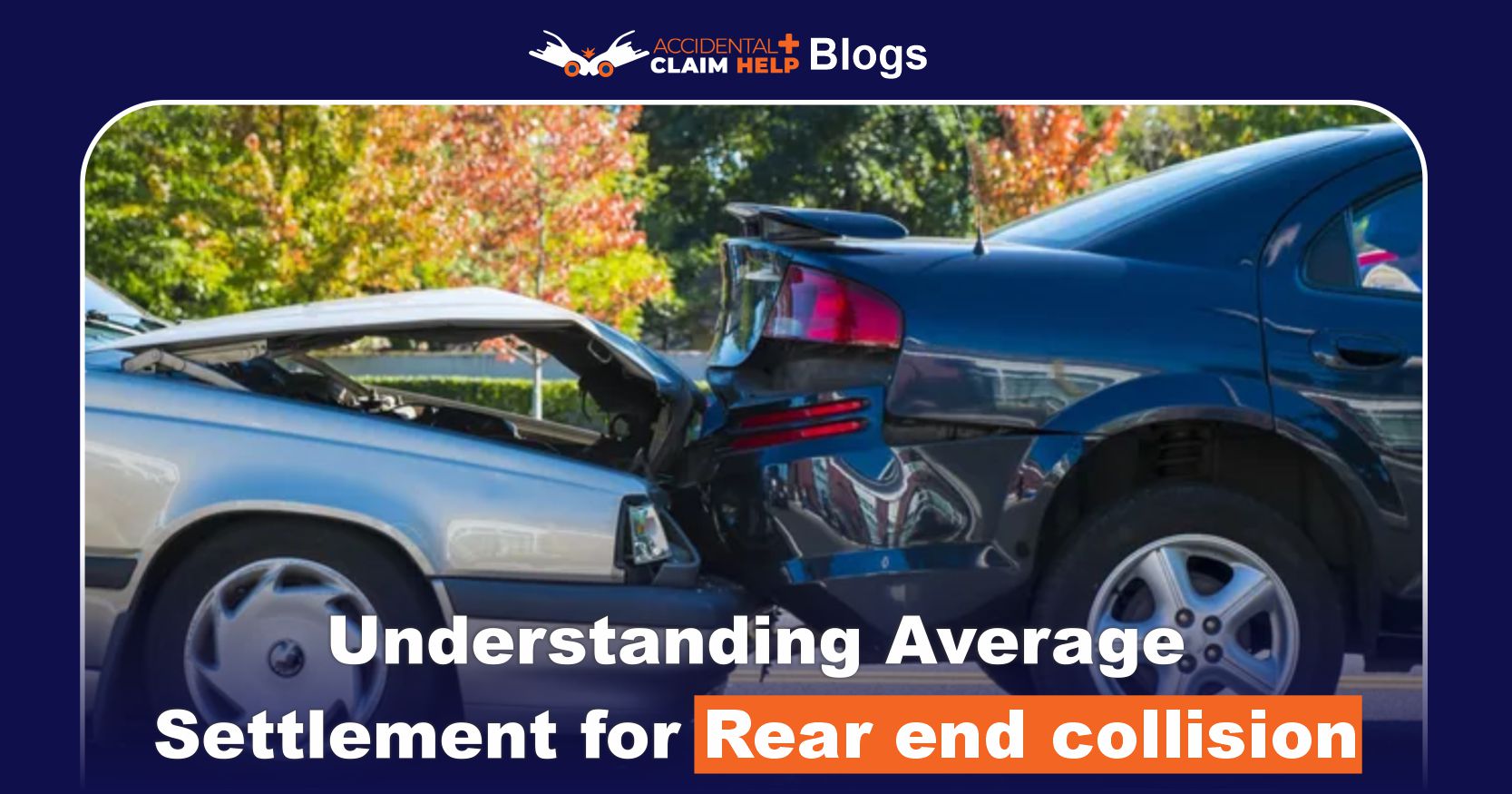Understanding Average Settlement for Rear end collision
Rear-end crashes are among the most common car accidents in the U.S. and can range from minor fender-benders to catastrophic wrecks. Settlements depend heavily on how badly you and your vehicle were hurt. Minor impacts often lead to modest payouts, while serious injuries can push settlements into six or seven figures. For example, one recent source notes that a minor rear-end crash (with soft-tissue injuries like whiplash) typically settles around $2,000–$10,000. More significant accidents – those causing herniated discs or fractures – often see settlements in the $15,000–$50,000 range. In the most severe rear-end collisions (spinal cord injury, traumatic brain injury, long-term disability), payouts can exceed $75,000–$250,000 or more. These figures include both bodily injury and property damage claims, with actual amounts varying by case.
Rear-end collisions can cause both injury claims and vehicle damage claims. Even a slight bump can bruise the body and dent the car, so settlements cover both medical bills and repair costs. For example, one illustrative breakdown showed a minor collision with $2,500 in vehicle damage, $6,000 in medical bills, and $1,500 lost wages, plus a few thousand in pain-and-suffering, yielding about $12,000–$20,000 total. Major crashes can generate much higher bills: one case study lists $70,000 in hospital and surgery costs, $15,000 lost wages, $12,000 car damage, and $50k–$100k in pain/suffering for a total around $160,000–$210,000. In practice, settlements combine economic damages (medical, lost wages, repairs) with non-economic damages (pain, suffering, life disruption).
Injury vs. Property Damage Claims
In a rear-end collision you typically have two claims: one for injuries (your health) and one for property damage (your car). Property damage claims usually pay to fix or replace your vehicle. In a minor crash, this might just cover a bumper repair or deductible (often a few thousand dollars). In the example above, the hypothetical car damage was $2,500. More severe crashes can total a car, so the insurer pays the car’s actual cash value (sometimes over $10,000–$20,000 if it’s a newer vehicle).

Injury claims reimburse your medical bills, lost income, and compensate for pain and suffering. Even soft-tissue injuries like whiplash (neck strain) or back sprains can rack up bills (doctor visits, X-rays, therapy). One analysis found that minor whiplash cases often settle around $5,000–$10,000. Herniated or bulging discs in the back or neck – common in higher-speed impacts – raise costs: these may require physical therapy or even surgery, driving average payouts into the tens of thousands. In short, the more serious the injury and the more treatment required, the larger the injury claim.
Calculating your settlement typically starts by totaling your out-of-pocket expenses (medical bills, rehab, car repairs, lost pay). For instance, if you miss work for recovery, insurance will look at pay stubs or tax records to compute lost wages. Then a “multiplier” may be applied for pain and suffering – often 1.5 to 5 times the economic losses depending on severity. Insurers also consider other intangibles: long-term pain, emotional distress, and how the crash affects daily life. Because of this, two rear-end cases can have wildly different values even if they look similar on paper.
Common Rear-End Crash Injuries
Whiplash (cervical strain) is very common even in low-speed collisions. It occurs when your head snaps forward and back, straining neck muscles and ligaments. Symptoms (neck pain, headaches, stiffness) can linger for weeks or months. Soft tissue injuries to the back, shoulders, and spine are also frequent – these include sprains/strains of ligaments, tendon tears, and muscle injuries. Though “minor,” such injuries still require treatment (chiropractic, physical therapy, medications) and can add thousands to a claim.
More severe impacts can injure the spine itself. Herniated or bulging discs in the neck or lower back may pinch nerves, causing numbness or pain. These often need advanced care (epidural injections or even surgery). For example, one California case study recorded $70,000 in hospital and surgical charges for back injuries. Other possible injuries include concussions or brain trauma if the head jostles, fractures (especially in the arms or legs as people brace), and even spinal cord injury in extreme cases. The settlement reflects this range: minor strains might only trigger $2,000–$10,000 claims, whereas a shattered vertebra or traumatic brain injury could push compensations into the hundreds of thousands.
How Damages Are Calculated
Insurers break down settlements into economic damages and non-economic damages. Economic damages are the “hard costs”: medical bills, ambulance fees, surgery, rehab, prescription drugs, car repair costs, rental car expenses, and lost wages. These are straightforward because you have invoices and pay stubs. For example, if you lost three weeks of work, documentation might show $2,000 in lost income. The insurance company will verify each item (they often ask for medical records and bills) and sum them up.
Non-economic damages cover pain, suffering, and other losses that aren’t bills. This includes physical pain from the injuries, emotional trauma (anxiety or PTSD after a crash), loss of enjoyment (inability to exercise or play with kids), and loss of consortium (strain on family relationships). These are calculated more subjectively, often by multiplying the economic total by a factor (commonly 1.5–5×). Factors increasing this portion are severity and permanence of injury – chronic pain or permanent disability means a higher multiplier. Some insurers and attorneys also use per-diem methods (assign a daily pain value), but multipliers are most common.
For example, in one mid-level case the insurers estimated about $2,000–$10,000 for non-economic damages on top of approximately $10,000 in economic costs. In the severe crash example above, the insurer valued the non-economic losses alone at $50,000–$100,000. The bottom line is that every medical dollar you spend becomes the base for calculating your pain and suffering compensation. Thorough, well-documented bills and strong evidence of ongoing pain will justify a higher non-economic award.
State-by-State Variations
Settlement outcomes can also vary by state due to different insurance rules and average costs. In California, for instance, one source notes average rear-end payouts roughly $5,000–$20,000 for minor injuries, $20,000–$50,000 for moderate injuries, and over $100,000 for severe cases. California uses pure comparative negligence, meaning you can recover damages even if you are partially at fault (your share just reduces the award). There’s no personal injury protection (PIP) limit, so all damages flow through tort claims.
In Texas, a similar breakdown applies: minor fender-benders average $2,000–$10,000, mid-range $15,000–$50,000, and catastrophic collisions $100,000–$500,000+. Notably, Texas has modified comparative negligence – you cannot recover if you’re 51% or more at fault. Texas also requires filing within two years of the crash. Texas law often covers more immediate and out-of-pocket losses, and major cases (e.g. commercial vehicle or drunk driver crashes) can have much larger settled amounts.
New York operates under a no-fault system. That means your own insurance (Personal Injury Protection or PIP) pays initial medical bills and up to 80% of wages (capped at $50,000 total, with only 80% of wages covered up to a limit). In practice, victims often exhaust PIP benefits quickly. To recover beyond those limits (especially for pain and suffering), you usually must prove a “serious injury” under New York law. Average New York rear-end settlements can range widely, but minor cases fall around $2,000–$10,000 (for very low-speed impacts), moderate injuries about $10,000–$50,000, and severe crashes easily $100,000–$1,000,000+. One New York survey found an average no-fault (PIP) settlement was only about $29,500 in 2022 (split ~$24,200 for bodily injury and ~$5,300 for property) – illustrating that serious injuries often need third-party claims or lawsuits to reach higher awards. Overall, state laws (fault rules, PIP thresholds) can limit or expand what you recover, so it’s wise to know your state’s rules on negligence and no-fault.
Factors That Increase or Reduce Your Settlement
Several key factors drive the final settlement amount:
- Injury Severity: More serious or permanent injuries command higher payouts. A simple bruise or short-term whiplash yields less compensation than a herniated disc or chronic pain condition.
- Medical Treatment and Timing: Getting prompt treatment and following doctors’ recommendations strengthens your case. Delaying care may make insurers question if you were really hurt. Keep all medical records and receipts – each visit and procedure adds weight to your claim.
- Pre-Existing Conditions: If you had old injuries (e.g. prior back problems), the insurer may argue the crash didn’t fully cause your pain. However, you can still recover the portion that the accident worsened, provided your doctors clearly link your current symptoms to the crash. Strong medical evidence of how the accident aggravated any condition is critical.
- Lost Income: Document any work missed or reduced earning capacity. The more income loss you prove (with pay stubs, employer letters, tax docs), the more your settlement will include for lost wages. Also consider future lost earnings if you can’t return to your old job due to injury.
- Vehicle Damage: Oddly, greater car damage often correlates with higher injury awards. A smashed front bumper or totaled car suggests a harder impact, making claimed injuries more believable. By contrast, a barely-touched car in a crash might make an adjuster skeptical – if your car “looks fine,” they may undervalue your injury claim.
- Fault and Liability: In most rear-end cases the driver in back is presumed at fault. But if the front driver was partially to blame (brake-checked, had no tail lights, etc.), fault can be shared. Shared fault reduces your award under comparative negligence rules: e.g., if you’re 20% at fault, your payout is cut by 20%. (In the few states with contributory fault, like Maryland, even 1% blame can bar recovery.)
- Insurance Limits: The at-fault driver’s liability policy sets an upper cap on insurance payouts. If your damages exceed those limits, you may need to look to your own uninsured/underinsured motorist coverage, or consider a lawsuit against other responsible parties (like a trucking company, for example).
Strong documentation always boosts your claim. Photographs of the crash scene and injuries, a thorough police report, medical records linking treatment to the accident, and witness statements make it harder for an insurer to deny or lowball your claim. Conversely, inconsistent stories or gaps in treatment can significantly reduce an offer. And remember, insurance companies often make a low first offer to see if you’ll accept it. Don’t jump at that initial number. Instead, prepare a counter-argument (a written response highlighting your damages) and ask the adjuster to justify any unreasonably low offer.
Negotiating Your Settlement
Negotiation is a key part of the process. Always start by documenting everything. When you’re ready to settle, send a clear demand letter outlining your injuries, losses, and a proposed settlement amount. If the insurer counters with a lowball offer, don’t panic or accept immediately. Politely ask them to explain their valuation, then rebut any weak points in writing. Stay factual but also emphasize the human side: explain how the injury affects your life and family. For example, note that “the insured was fully at fault,” “you suffered significant pain,” or “medical treatment was necessary and reasonable.” If you have photos (of the wrecked car or visible injuries), refer to them. Emotional details like “I was in constant pain, couldn’t play with my children for weeks” can help put a fair value on your non-economic losses.
Try to keep negotiations in writing (emails or letters) so there’s a record. Don’t agree to settle on a phone call. When finally you agree on an amount, confirm it in a short written note specifying what injuries it covers and when you expect payment. This ensures everyone is on the same page.
Remember, you can often negotiate up from the insurer’s offer. If their first offer is low, you can counter just slightly below your demand figure to show willingness to compromise. If they claim you have no real injuries, ask them to provide specific reasons, then respond with evidence. For instance, if they say “you had no medical treatment,” you can reply, “Actually, here are my doctor notes and bills.” This back-and-forth often leads to a fair middle ground.
Hiring an experienced personal injury attorney is another form of negotiation strategy. An attorney knows what evidence to gather and how to pressure adjusters (for example, by implying a lawsuit if they don’t play fair). The very act of having a lawyer can push an insurer to raise its offer – they know trial verdicts often favor plaintiffs. (Interestingly, data show that over 90% of injury cases that go to trial end in favor of the accident victim. This means insurers may increase offers rather than risk a jury verdict.)
The Claims Process: What to Expect
If you’re involved in a rear-end crash, here’s a rough roadmap of the claim process:
- Immediately after the crash: First, ensure safety. Move off the road if possible, call 911 and get a police report. If safe, take photos of all vehicles, damage, and the scene. Gather contact info from the other driver and any witnesses. Seek medical attention right away, even if you feel okay – injuries like whiplash can show symptoms later. A medical exam creates an official record that the crash caused your injuries.
- Notify insurers: Report the accident to your own insurance company and, if there is an obvious at-fault driver, to their insurer. Provide facts (date, location, police report) but be careful – do not admit any fault or guess at what caused it. The adjuster will ask for a statement; keep it factual and brief, and remember they work for the other side’s bottom line.
- Investigation: The insurance company will open a claim file and investigate. They may ask for documentation: doctor’s reports, hospital bills, photos of damage, and witness statements. They sometimes send an adjuster to inspect the car or talk to you. During this time, keep up with all recommended medical care. Insurance may question why you stopped treatment, so show you followed doctors’ advice.
- Settlement negotiations: Once you have a clear sense of your total damages (after treatment and recovery stabilized), you or your lawyer will submit a demand letter to the insurer. This summarizes your losses and asks for a specific amount. The insurer will respond with an offer or a low counteroffer. Negotiations (often via letter or calls) ensue until you either reach an agreement or decide to escalate.
- Resolution: If you agree on an amount, the insurer will draft a release form and payment. The release will cover the stated injuries and prevent future claims on that accident, so read it carefully. If you don’t agree, you can threaten a lawsuit (or actually file one) to keep pressure on the insurer. Many cases settle even after a lawsuit is filed.
- Timeline: Simple cases can settle in a few months, but with more severe injuries it often takes longer. In New York, for example, minor claims may wrap up in under a year, but complex cases involving surgery can take 2–3 years. In general, settle only after you’ve reached maximum medical improvement (your doctors say you’re recovered as much as you’re going to be). Rushing to settle before that can leave future care unpaid.
Tips to Maximize Your Settlement
- Document everything: Keep medical records, bills, and a daily journal of your symptoms and pain. Write how the injuries affect your life (no sleeping, missing family events, etc.) – this can be powerful evidence of your suffering.
- Get prompt treatment: Seeing a doctor soon after the crash helps tie your injuries to the accident. Don’t skip appointments; insurers expect you to follow the treatment plan.
- Communicate carefully: When talking to adjusters, stick to facts and never apologize or admit fault. You can say, “I’m sorry you’re injured,” but not “I’m sorry it happened.”
- Keep deadlines in mind: File injury and property claims within your state’s statute of limitations (often 1–3 years). In Texas it’s 2 years; in New York it’s 3 years for most car injuries. Missing these deadlines usually bars recovery.
- Understand your coverage: If the other driver has low limits, see if your own uninsured/underinsured motorist (UM/UIM) policy can help. Also check if any family member passengers can sue the at-fault driver (they typically can, even if you’re driving).
- Negotiate wisely: As noted, don’t accept the first offer. Counter with a reasonable but firm demand. You might say, “I’m willing to settle for $X given my bills and pain,” and stand by it. Use advice from legal guides: get the adjuster to justify any low offer, then respond point-by-point.
- Put agreements in writing: Once you agree on a settlement number, send a confirmation letter listing what it covers. This avoids any last-minute confusion.
- Consider an attorney: Especially for significant injuries, a lawyer can handle all these details. They usually work on contingency (no fee unless you win), so it costs nothing up front. Attorneys know how to maximize claims, counter low offers, and, if needed, file a lawsuit to push the case. Studies show that having legal representation generally leads to higher settlements, because lawyers can navigate the process and negotiate aggressively.
What to Expect from Insurance
Insurance adjusters often try to minimize payouts. They may downplay injuries (“see, your X-ray was normal”) or pressure quick settlement. Be wary of any “take it or leave it” attitude. You have the right to ask them to explain each denial or low offer, and to patiently negotiate. Remember that most cases settle out of court, so insurers know they may have to offer more if you are prepared to go to trial.
In no-fault states (like New York or Florida), initial benefits come from your own policy. In New York, for example, PIP covers medical expenses up to $50,000 (minus 20% of your wages) and up to $2,000/month. But these payments have strict limits and often end before you’re fully healed. If you’ve suffered a “serious injury” under state law (fractures, permanent injury, significant scars, etc.), you can sue the at-fault driver for additional damages including pain and suffering.







